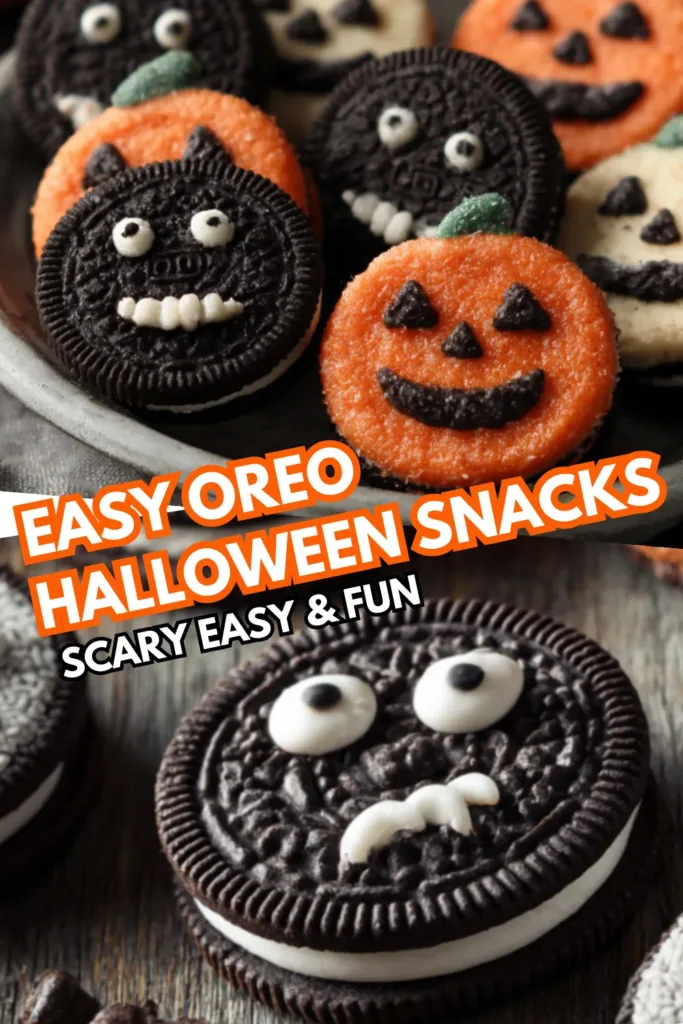These Halloween Oreo Treats are dipped, decorated sandwich cookies that deliver bakery-level shine and sharp details with minimal effort. The base method makes clean, crisp coatings that set at room temperature, and the decorations—mummies, spider webs, and monster eyes—use pantry toppings kids can help place. Follow the precise melting temperatures and resting times below for smooth shells, vivid colors, and treats that package well for parties.
Ingredients & Measurements
- Yield: 24 decorated Oreos (8 mummies, 8 spider webs, 8 monster eyes)
- 24 chocolate sandwich cookies (standard Oreo-type; not double-stuf)
- 300 g (10 oz) bright white candy melts or white couverture candy wafers
- 200 g (7 oz) orange candy melts
- 200 g (7 oz) purple or green candy melts (choose one)
- 3–4 tsp neutral oil or refined coconut oil, divided (thins coatings for clean dipping)
- 32–48 small candy eyes (you’ll use 2 per mummy or monster)
- 30 g (1 oz) semi-sweet chocolate chips + 1 tsp oil (for web lines and pupils)
- 40 g (1/4 cup) Halloween sprinkles (jimmies + nonpareils)
- 24 lollipop sticks (optional, for Oreo pops)
- Parchment paper or silicone mats for two baking sheets

Step-by-Step Instructions
- Prepare pans and workspace. Line two rimmed baking sheets with parchment or silicone mats. Clear a cool countertop for setting (ideal room temp is 18–22°C / 65–72°F). Having a wide, clean area prevents smudges while the coatings firm.
- Stabilize the cookies. If making pops, gently twist apart 24 cookies. Dip the tip of each lollipop stick in 1/2 tsp melted white coating (from Step 3), press into the crème of one cookie, and sandwich with its mate. Let set on a tray 10 minutes before dipping so sticks anchor securely.
- Melt the white coating to fluid ribbons. Place 300 g white melts plus 1–1½ tsp oil in a microwave-safe bowl. Heat at 50% power in 30-second bursts, stirring between, until smooth and just warm to the touch (31–32°C / 88–90°F; about 90 seconds total). A fluid ribbon that falls off the spoon ensures thin, glossy shells.
- Dip for a clean baseline. Working 6–8 cookies at a time, submerge each cookie in the white coating; lift with a fork and tap gently on the bowl rim 8–10 times to shed excess. Scrape the fork underside on the rim for a clean edge, then slide onto the prepared sheet using a toothpick. Repeat for 8 cookies (these will be mummies). If the coating thickens, rewarm 10–15 seconds at 50% power.
- Create mummy bandages. Scoop 3–4 Tbsp of the remaining white coating into a small zip-top bag. Snip a 2–3 mm tip and pipe thin, slightly angled stripes across the first 8 cookies, leaving a small gap for eyes. Place two candy eyes per cookie while the stripes are still tacky. Let set 15 minutes at room temp.
- Melt color coatings for webs and monsters. In separate bowls, melt 200 g orange melts with 1 tsp oil and 200 g purple (or green) melts with 1 tsp oil using the same 50% power/30-second intervals. Aim for the same 31–32°C / 88–90°F range—hotter coatings can crack as they cool.
- Dip spider-web cookies. Dip 8 cookies in orange coating; tap off excess and place on the sheet. Melt chocolate chips with 1 tsp oil in 15-second bursts until smooth. Transfer to a small bag, snip a tiny 1–2 mm tip, and pipe 3–4 concentric circles on each orange cookie. Drag a toothpick from center to edge 6 times to form webs, wiping the tip between drags for sharp lines. Set 15 minutes.
- Dip monster-eye cookies. Dip the remaining 8 cookies in purple (or green) coating; tap off excess and set on the sheet. While still tacky, add 2–3 candy eyes per cookie in random clusters. Pipe a tiny chocolate dot on each eye for pupils if desired. Finish with a few sprinkles along one edge for texture contrast. Set 15 minutes.
- Tidy edges and finish shine. Once set, use a small paring knife to trim any stray drips from cookie bases. For a polished look, very briefly rewarm each coating (5–10 seconds at 50% power) and flick a few ultra-thin drizzle lines over the monster cookies or around web edges. Allow a final 10 minutes to dry.
- Package and hold properly. Transfer fully set cookies to mini cupcake liners, then into airtight tins or treat bags. Store at cool room temp (not the fridge) for up to 10 days. Refrigeration can cause condensation that dulls the surface; if your kitchen is hot, store in the coolest dry cupboard you have.
- Convert to Oreo pops (optional). For pops, insert sticks into small cellophane bags once the coatings are fully set. Tie with ribbon and add a paper tag. For straight-up cookies, layer between parchment in a rigid container to prevent scuffing.
- Scale precisely for parties. For 48 cookies, double every ingredient and melt coatings in two batches to maintain ideal fluidity; candy melts thicken if held warm too long. Keep each color at working temperature by setting the bowl over a warm (not hot) water bath—38–40°C / 100–105°F on the bowl bottom is perfect.
- Clean up efficiently. While bowls are still slightly warm, wipe them with paper towels to remove residual coating, then wash. Hardened drips peel off parchment easily; brush crumbs into the bin to keep your work area tidy.
Cooking Notes
- Why candy melts: Unlike pure chocolate, candy melts set hard at room temperature without tempering and resist bloom under party lights. If you prefer real white chocolate, temper to 29–30°C / 84–86°F before dipping for a glossy finish.
- Oil accuracy: Add oil sparingly—1 tsp per 200 g coating is a good starting point. Too much oil leaves a soft set; too little produces thick, bumpy shells.
- Cookie choice: Standard-fill cookies hold lollipop sticks better and are less likely to separate while dipping. If using double-stuf, press gently to seat the stick or add a dab of coating as “glue.”
- Color planning: Classic Halloween reads best with white/orange/purple (or green) plus dark chocolate accents. Avoid liquid food color in coatings; it can seize. Use pre-colored melts or oil-based candy dye.
- Temperature control: Overheated melts can turn grainy or streak as they cool. Stick to 50% microwave power and the temperature ranges above; frequent stirring distributes heat evenly.
- Allergy and dietary swaps: Use certified gluten-free sandwich cookies and allergen-safe eyes for school events. Vegan options exist for sandwich cookies and candy eyes; check labels and use dairy-free melts.
- Design alternatives: Add “stitches” with short chocolate lines on monster cookies; press a mini pretzel on top of an orange-dipped cookie for a pumpkin “stem”; or use licorice laces cut into tiny legs to turn a halved chocolate button into a spider.
- Humidity caution: High humidity can dull coatings. If the air is damp, run a dehumidifier in the kitchen for 30–45 minutes before dipping to keep finishes crisp and shiny.
- Make-ahead strategy: Dip and decorate up to 7–10 days in advance. If bagging, let cookies cure 2 hours after decorating so no transfer occurs inside the bag.
- Kid helper tips: Pre-stage eyes in small bowls and pre-fill piping bags. Assign one job per child—placing eyes or adding sprinkles—to keep decorations neat and the workflow smooth.
Nutrition Facts (per serving)
- Serving size: 1 decorated cookie
- Approximate calories: 140 kcal
- Total fat: 7 g
- Saturated fat: 4 g
- Carbohydrates: 19 g
- Dietary fiber: <1 g
- Total sugars: 14 g
- Protein: 1 g
- Sodium: 70 mg
Conclusion
With a smooth dip, quick drizzle work, and a handful of candy eyes, these Halloween Oreo Treats deliver maximum spooky impact for minimal hands-on time. The coatings set hard with a clean shine, the designs stay crisp even on a busy buffet, and the cookies hold beautifully for gifting or school parties. Use the base method, rotate colors for variety, and you’ll have a tray of mummies, webs, and monsters that look professional and taste great—scary easy, every time.


